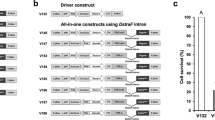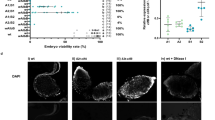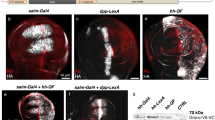Abstract
We introduced a firefly luciferase gene, expressed under control of Drosophila heat shock protein gene promoter, into Autographa californica nuclear polyhedrosis virus (AcNPV). When the 5th instar larvae of the silkworm, Bombyx mori, were inoculated with the recombinant virus, luciferase activities were detected in the virus-infected larvae and pupae, and in the newly hatched larvae of the next generation. PCR amplification and Southern blot hybridization analysis demonstrated that the luciferase gene was transmitted through at least the F2 generation. In addition, the V-cathepsin gene, encoding a cysteine protease of AcNPV, was also detected in the DNA of all individuals of the F2 generation. These results show that AcNPV can be utilized as vector for the transovarian transmission of foreign genes in the silkworm.
This is a preview of subscription content, access via your institution
Access options
Subscribe to this journal
Receive 12 print issues and online access
$209.00 per year
only $17.42 per issue
Buy this article
- Purchase on Springer Link
- Instant access to full article PDF
Prices may be subject to local taxes which are calculated during checkout
Similar content being viewed by others
References
Ayres, M.D., Howard, S.C., Kuzio, J., Lopez-Ferber, M. and Possee, R. D. 1994. The complete DNA sequence of Autographa californica nuclear polyhedrosis virus. Virology 202: 586–605.
Luckow, V.A. and Summers, M.D. 1988. Trends in the development of baculovirus vectors. Bio/Technology 6: 47–55.
Miller, L.K. 1988. Baculoviruses as gene expression vectors. Ann. Rev. Microbiol. 42: 177–199.
Jarvis, D.L., Fleming, J.G.W., Kovacs, G.R., Summers, M.D. and Guarino, L.A. 1990. Use of early baculovirus promoters for continuous expression and efficient processing of foreign gene products in stably transformed lepi-dopteran cells. Bio/Technology 8: 950–955.
Jarvis, D.L. 1993. Effect of baculovirus infection on lEl-mediated foreign gene expression in stably transformed insect cells. J. Virol. 67: 2583–2591.
Morris, T.D. and Miller, L.K. 1992. Promoter influence on baculovirus-mediated gene expression in permissive and nonpermissive insect cell lines. J. Virol. 66: 7397–7405.
Morris, T.D. and Miller, L.K. 1993. Characterization of productive and non-productive AcMNPV infection in selected insect cell lines. Virology 197: 339–348.
Summers, M.D., Volkman, L.E. and Hsieh, C.-H. 1978. Immunsperoxidase detection of baculovirus antigens in insect cells. J. Gen. Virol. 40: 545–557.
Volkman, L.E. and Goldsmith, P.A. 1982. Generalized immunoassay for Autographa californica nuclear polyhedrosis virus infectivity in vitro. Appl. Environ. Micro. 44: 227–233.
Maeda, S., Mukohara, Y. and Kondo, A. 1990. Characteristically distinct isolates of the nuclear polyhedrosis virus from Spodoptera litura. J. Gen. Virol. 71: 2631–2639.
Longworth, J.F. and Cunningham, J.C. 1968. The activation of occult nuclear-polyhedrosis viruses by foreign nuclear polyhedra. J. Invertebr. Pathol. 10: 361–367.
Podgwaite, J.J. and Mazzone, H.M. 1986. Latency of insect viruses. Adv. Virus Res. 31: 293–308.
Hughes, D.S., Possee, R.D. and King, L.A. 1993. Activation and detection of a latent baculovirus resembling Mamestra blassicae nuclear polyhedrosis virus in M. brassicae insects. Virology 194: 608–615.
Mori, H., Nafcazawa, H., Shifai, N., Shibata, N., Sumida, M. and Matsubara, F. 1992. Foreign gene expression by a baculovirus vector with an expanded host range. J. Gen. Virol. 73: 1877–1880.
O'Reilly, D.R. and Miller, L.K. 1989. A baculovirus blocks insect molting by producing ecdysteroid UDP-glucosyltraasferase. Science 245: 1110–1112.
O'Reilly, D.R. and Miller, L.K. 1992. Alteration of ecdysteroid metabolism due to baculovirus infection of the fall army worm Spodoptera frugiperda: host ecdysteroids are conjugated with galactose. Insect Biochem. Molec. Biol. 22: 313–320.
Toeroek, I. and Karch, F. 1980, Nucleotide sequences of heat shock activated genes in Drosophila metanogaster. I. Sequences in the regions of the 5′ and 3′ ends of the hspTO gene in the hybrid ptasmid 56h8. Nucleic Acids Res. 8: 3105–3123.
Rawlings, N.D., Pearl, L.H. and Buttle, D.J. 1992. The baculovirus Autographa californica nuclear polyhedrosis virus genome includes a papain-like sequence. Biol. Chem. Hoppe-Seyler 373: 1211–1215.
Slack, J.M., Kuzio, J. and Faulkner, P. 1995. Characterization of v-cath, a cathepsin L-like proteinase expressed by the baculovirus Autographa californica multiple nuclear polyhedrosis virus. J. Gen. Virol. 76: 1091–1098.
Matsuura, Y., Possee, R.D., Overton, H.A. and Bishop, D.H.L. 1987. Baculovirus expression vectors: the requirements for high level expression of proteins, including glycoproteins. J. Gen. Virol. 68: 1233–1250.
De Wet, J.R., Wood, K.V., De Luca, M., Helinski, D.R. and Subramani, S. 1987. Firefly luciferase gene: structure and expression in mammalian cells. Mol. Cell. Biol. 7: 725–737.
Author information
Authors and Affiliations
Rights and permissions
About this article
Cite this article
Mori, H., Yamao, M., Nakazawa, H. et al. Transovarian Transmission of a Foreign Gene in the Silkworm, Bombyx mori, by Autographa californica Nuclear Polyhedrosis Virus. Nat Biotechnol 13, 1005–1007 (1995). https://doi.org/10.1038/nbt0995-1005
Received:
Accepted:
Issue Date:
DOI: https://doi.org/10.1038/nbt0995-1005
This article is cited by
-
Baculovirus-mediated gene transfer in butterfly wings in vivo: an efficient expression system with an anti-gp64 antibody
BMC Biotechnology (2013)
-
Site-specific gene integration in cultured silkworm cells mediated by φC31 integrase
Molecular Genetics and Genomics (2006)
-
Copying and manipulating nature: Innovation for textile materials
Fibers and Polymers (2003)



